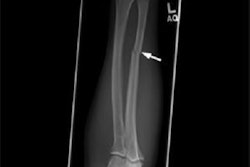A radiologist-led team from Toronto has identified a gestalt of injuries and surrounding social context common to most cases of physical abuse of the elderly. The group believes this could be a guide to identifying victims of elder abuse, much as a pediatric radiologist defined the signs of shaken-baby syndrome in the 1940s.
Statistics Canada estimates that between 4% and 10% of senior citizens are victims of elder abuse. In fact, elder abuse is a significant problem across North America, Dr. Kieran Murphy told attendees at the Canadian Association of Radiologists (CAR) annual scientific meeting. However, physicians currently report only about 2% of cases for several reasons, including uncertainty of diagnostic validity, he noted.
"In other words, in falls or other traumas that occur commonly in the elderly, how do you differentiate the accident from an injury that is not accidental?" asked Murphy, who is vice chair and director of research in the Joint Department of Medical Imaging at the University of Toronto and the University Health Network. "Just as in the case of shaken-baby syndrome, context is critical for a conclusive diagnosis."
The context of elder abuse
To get a fix on the pattern of physical injuries associated with elder abuse, the team searched PubMed, CINAHL, Embase, and Trip databases. In addition, to fully understand the general context of elder abuse, they met with nurses from various senior-care organizations in Ontario, and with Dr. Roger Skinner, the supervising regional coroner for Eastern Ontario and the former chair of a committee examining suspicious deaths of elderly Ontario residents.
The team uncovered a handful of relevant papers, which together include 1,100 cases of suspected elder abuse. They determined that the physical findings almost always comprise cranial, maxillofacial, periorbital, dental, laryngeal, and/or to a lesser extent upper extremity and torso injury.
For example, a review of 15 autopsies of elder-abuse victims in Japan indicated that subdural hemorrhage was the most common cause of death (Legal Medicine, March 2003, Vol. 5:1, pp. 7-14).
"Those of us who read head scans are often struck by the [large] number of subdural hemorrhages in elderly patients," Murphy said.
Murphy and colleagues also confirmed that while each of these injury types is nonspecific to elder abuse, their distribution and extent are not congruent with accidental injury. For example, abuse victims have bruises that are usually larger than those seen with accidental injury and are located on the face, lateral right arm, or posterior torso (Journal of the American Geriatrics Society, July 2009, Vol. 57:7, pp. 1191-1196). Moreover, a Brazilian review of 87 cases of elder abuse showed that 33.5% had unspecified superficial shoulder and arm trauma (Latin American Journal of Nursing, May-June 2008, Vol. 16:3, pp. 465-470)
One of the other elements of the pattern for physical elder-abuse is that the victims are likely to have neurological deficit or dementia -- a well-documented risk factor for abuse. In addition, they are likely to have signs of neglect, such as being significantly underweight or having decubitus ulcers or poor hygiene.
Furthermore, the perpetrators are usually not formal caregivers, but rather informal caregivers such as the victim's child, grandchild, or daughter- or son-in-law. Often the victim is also socially isolated, and the caregiver/perpetrator has a history of mental illness or depression or alcohol or drug abuse.
"Knowing this pattern, we could develop a tool for screening for physical abuse in the elderly, such as an elder-abuse suspicion index, which could be used in community health clinics and emergency departments," Murphy said. "The key is that the physical findings have to be put in a social context in order to avoid overinterpretation."




















